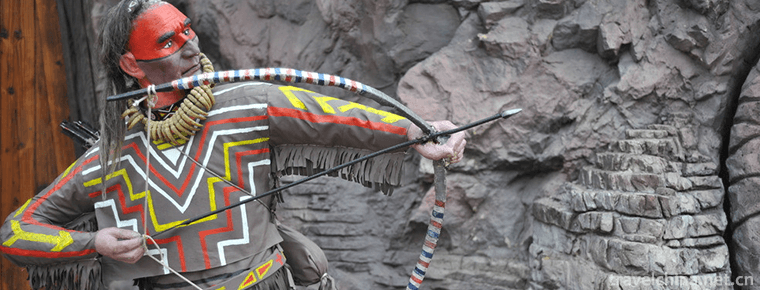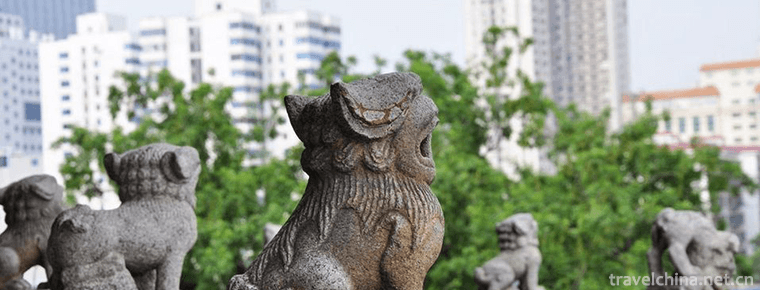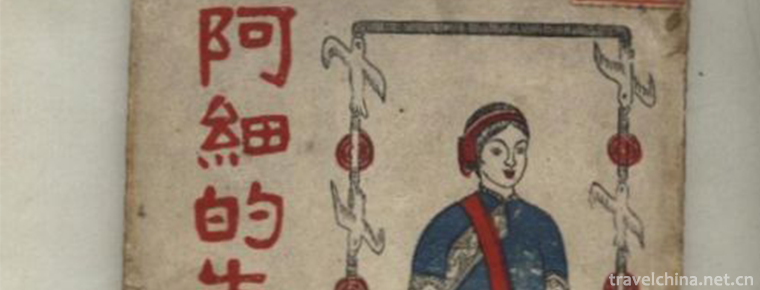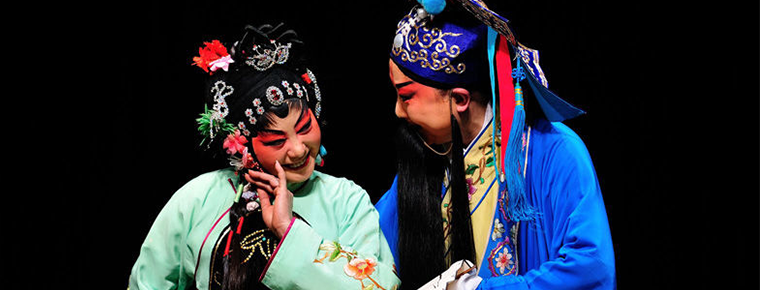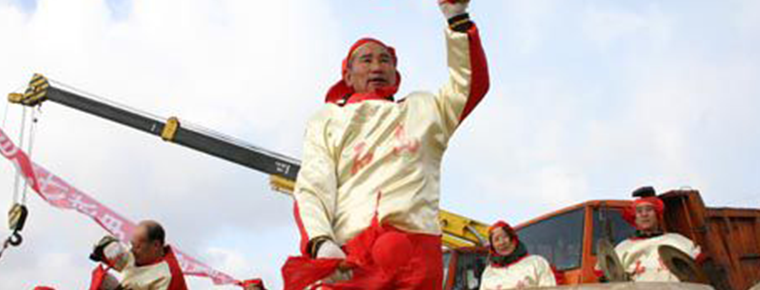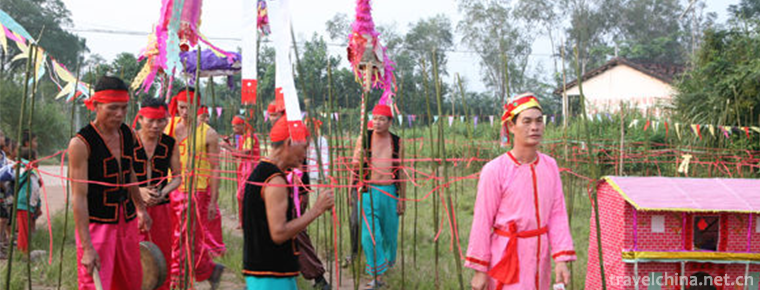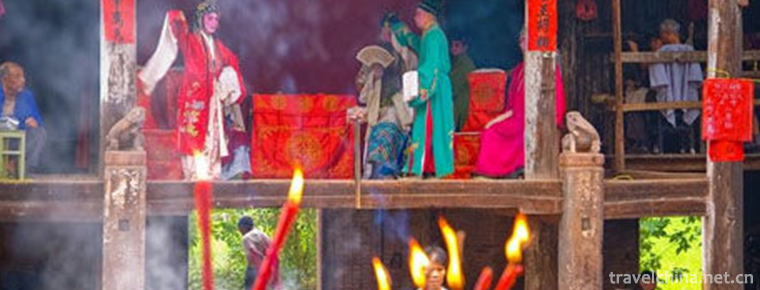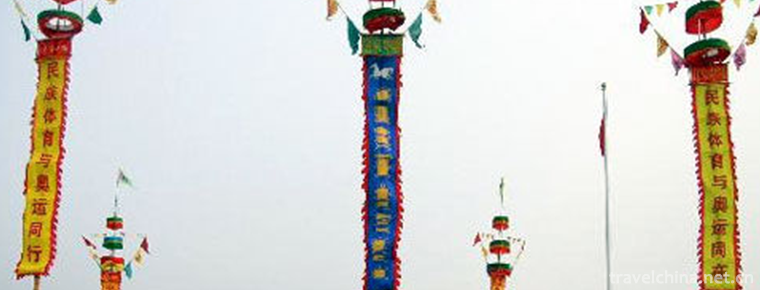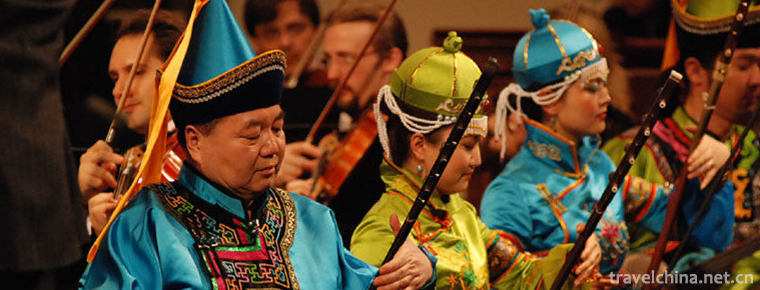Xi an Drums Music
Xi an Drums Music
Xi'an drum music, also known as Chang'an ancient music. It is a large-scale traditional folk drum music spread in Xi'an (ancient Chang'an) and its surrounding areas for thousands of years. It originated in Sui and Tang dynasties. After Song, Yuan, Ming and Qing dynasties, it still maintains a fairly complete repertoire, spectrum, structure, musical instrument and performance form.
Xi'an drum music is one of the most complete large-scale folk music found and preserved in China so far. It is an important relic of ancient Chinese traditional music and is praised as "the living fossil of ancient Chinese music" by the international music and historical circles.
At the 4th meeting of the UNESCO Intergovernmental Committee for the Protection of Intangible Cultural Heritage, held in Abu Dhabi, United Arab Emirates, on 30 September 2009, it was included in the List of Representatives of Human Intangible Cultural Heritage.
Brief introduction
Xi'an drum music, also known as Chang'an ancient music. It is a large-scale folk drum music that has been circulating in Xi'an (ancient Chang'an) and its surrounding areas for thousands of years.
Born out of Yanyue in Tang Dynasty, it melted into court music and gradually flowed into folk Xi'an drum music. After excavation, rescue and protection by a large number of cultural workers, it went through a long and arduous process of declaration and became a world-class intangible cultural heritage.
Xi'an Drum Music is one of the most complete large-scale folk music found and preserved in China so far. It was born in Yanyue of Tang Dynasty and then melted into court music. During the Anshi Rebellion, it flowed into the folk with the exile of court musicians.
historical origin
History of Development
Tracing back to its historical origin, from the aspects of structure, music score, song name and using musical instruments, it is closely related to the big tunes in Yanyue of Tang Dynasty. According to the analysis and investigation of data, Xi'an drum music may originate from Tang Dynasty, rise from Song Dynasty to Yuan Dynasty, Ming Dynasty and flourish in Qing Dynasty. After thousands of years of practice and development, especially Ming Dynasty and Qing Dynasty. Since the Qing Dynasty, the influence of opera music has gradually formed a complete set of large-scale national classical music forms.
Chang'an drum music still preserves the most traditional drum performance form, structure, musical instruments, music cards and spectrum.
Protecting History
The collection and arrangement of Xi'an drum music began in 1951. The competent unit is the Northwest Branch of the All-China Musicians Association (hereinafter referred to as the Northwest Musicians Association), which was established in 1950, and later renamed as the Xi'an Branch of the Chinese Musicians Association, which was established on March 6, 1955. At that time, the staff who participated in the collection and collation of Xi'an drum music were Li Shigen, deputy director of Northwest Music Association, Fan Zhaoming, music cadre of Northwest Music Association, and He Jun, music cadre of Shaanxi Mass Art Museum. In May 1953, Li Shigen, He Jun and others took Nanjixian Village in Zhouzhi County as their main base, focusing on the investigation of the types of drum music, and named it "Xi'an drum music".
After ten years or so, Li Shigen, Yang Yinliu, He Jun and others collected eight music clubs in Xi'an, Town God's Temple, Dong Cang, Xilang, Da Ji Chang, Changan hejiaying, Zhouzhi, Jixian and so on, interviewed 200 artists, and recorded more than 40 hours, collecting more than 100 volumes of folk music, which were close to those of the Song Dynasty. From 1959 to 1965, more than 800 pieces of music were compiled and published a set of five volumes of the compilation of the translated music of Xi'an Drum with more than 2 million words. It also possesses a large number of artists'oral transcripts and photographs, physical materials (mainly copies of popular characters) and other materials.
Yang Yinliu also found that Xi'an Drum Music and Shanxi's eight sets of Gongchi Score Subtraction Score and Character Score System were in line with the Southern Song Dynasty's Baishi Taoist Song. Later, the study of Song Jiang Baishi's Song Creation, published in cooperation with Yinlu Fa, interpreted Jiang Kui's Ci Music to a large extent due to the discovery of Xi'an Drum Music.
In the ten years from 1966 to 1976, the collection and arrangement of drum music in Xi'an was forced to stop because of the "Cultural Revolution". Work resumed in 1980. In 1981, with the approval of Shaanxi Cultural Bureau, the Yanyue Research Room of the Tang Dynasty (under the Shaanxi Mass Art Museum) was established. Li Shigen was the director and He Jun was the deputy director. Quyun, Li Buyun, Li Mingzhong, Li Jianzheng and Lu Hongjing participated successively. After the establishment of the research lab, it was based on the data of the compilation of the translated scores of Xi'an drum music printed in the 1960s.
From December 1981 to May 1982, we compiled eight volumes, nine volumes and more than 3 million words of Xi'an Drum Music Collection, which was compiled into 722 sets (pieces) of drum music collected by many people during the 30 years from 1951 to 1981.
During this period, Li Shigen wrote and published such papers as "Summary of Yanyue in Sui and Tang Dynasties", "Style Structure of Tang Daqu and Xi'an Drum Music", "Study and Interpretation of the Popular Characters of Xi'an Drum Music", "Comparative Study of Japanese Yayue and Xi'an Drum Music". He Jun, Lu Hongjing, Quyun, Li Jianzheng and Liu Junping wrote about the time value of "beat" in Tang Dynasty, Japanese Yayue and Xi'an Drum. The relationship between music, the origin of Gongchi score, the research and interpretation of popular character score, and the textual research and interpretation of Xi'an drum music style. Li Shigen also wrote hundreds of thousands of words monographs (mimeographs, not officially published) such as "A Brief Understanding of the Art Tradition of Xi'an Drum Music", which had a significant impact on the academic and music circles at home and abroad.
Professor Feng Yalan, Wu Wenbin, later comrades Cheng Tianjian and Jiao Jie, or score, or writing, or publishing special collections, all contributed to the collection, collation and research of Xi'an drum music.
Ren Bantang, Huang Xiangpeng, Ye Dong, He Changlin, Rao Zongyi, Xu Changhui, Yuan Jingfang and Chengxiong on the shore of Japan, Biken of Cambridge University, Zhong Sidi of London University, and music experts from Germany, Hungary, Austria, Italy, the United States and Canada have interviewed Xi'an drum music many times. People, collectors and researchers have highly appraised their art and research achievements.
With the deepening of the collection, collation and research of Xi'an drum music, it has attracted great attention and wide support from the music circles and academia all over the country. In 1985, Shaanxi Institute of Art established "Xi'an Drum Music Research Room". In addition to in-depth study of Xi'an Drum Music, Li Shibin, He Jun, Li Enkui, Li Mingzhong and Liu also participated in the compilation of "Shaanxi Volume of Integrated Chinese Ethnic and Folk Instrumental Music". In June 1987, Shaanxi Xi'an Drum Orchestra entered Beijing and participated in the Fifth Chinese Voice Concert and performed for the "Asian Traditional Music Symposium". The performances included Daji Changle Club in Xi'an, Nanji Xianle Club in Zhouzhi County and He Jiaying Music Club in Chang'an County. The performance won high marks from musicians at home and abroad.
Du evaluation, known as Xi'an drum music is "the living fossil of ancient Chinese music".
In December 1992, the People's Music Publishing House published a major national scientific research project, Shaanxi Volume, sponsored by the Ministry of Culture and approved by the Leading Group of National Art and Science Planning. It compiled 153 representative pieces (sets) of more than 20 genres of Xi'an drum music, with about 710,000 words, so that Xi'an drum music was officially recorded in the history of Chinese music.
In early 2004, Xi'an established a leading group for the protection and development of drum music in Xi'an. In the same year, Xi'an Drum Music was listed as the second batch of national folk culture protection projects. The Office of the Leading Group soon formulated plans and measures for protection and development, conducted a comprehensive census, confirmation, registration and filing of Xi'an drum music, and provided rescue protection for the music scores and senior inheritors. In just one year, it collected more than 1,000 ancient music materials and some audio-visual materials, and organized a series of exhibitions, performances and activities.
In early 2005, the Propaganda Department of Xi'an Municipal Committee also allocated special funds for rescue recording and recording. The Municipal Music Office organized television stations to shoot documentaries for old artists, and organized nine music societies to record a complete set of performances. In addition, the Propaganda Department of the Municipal Committee has allocated special funds to publish the Xi'an Drum Music Album Rain Ling with Xi'an Conservatory of Music. At the 15th International Council on Monuments and Sites and Eurasian Forum, the Propaganda Department of the Municipal Committee convened several music clubs to organize large-scale drum music performances at the airport, which gave Chinese and foreign guests a boost. At the end of the same year, the good news came that Xi'an drum music was listed in the national "non-legacy" list.
On the afternoon of October 11, 2017, the listing ceremony of Xi'an Drum Music Society was solemnly held in Xi'an Conservatory of Music. All the teachers and students of the Department of Musicology and the Drum Music Society of Xianxi Village in Nanji attended the listing ceremony.
artistic characteristics
Music
Nowadays, the music scores used by Chang'an Drum Music Clubs are still half-character scores of ancient times, all handwritten copies, and still retain the Handbooks of Ming Dynasty. Some notes are the same as those of the Tang music excavated in Dunhuang Mogao Grottoes. The existing collection of Xi'an Drum Music Handwritten Scores in the 28 years of Qianlong in the Qing Dynasty is basically the same as that of Jiang Kui's seventeen self-tunes in the Song Dynasty, which proves that this collection has a long history and is a popular music score that has gradually lost in the whole country since the Ming and Qing Dynasties.
Qu card
Looking at the name of the whole music, it can be said that it is a history of the development of Chinese music that retains all kinds of music cards in Tang, Song, Yuan, Ming and Qing Dynasties. Since the Tang and Song Dynasties, many musical factors (temperament, tune, lyrics, music score, musical instruments, structure, rotation, etc.) of Chinese music have left traces in this ancient music. It is not enough to call Chang'an drum music the "living fossil" of Chinese ancient music.
structure
According to the textual research of music historians, during the Anshi Rebellion of the Tang Dynasty, the court musicians fled among the people, and the Yanyue music of the Tang Dynasty also spread among the people. Chang'an drum music originated from Yanyue in Tang Dynasty. It is atmospheric, solemn, elegant, rich in repertoire, complete in structure and beautiful in tune. It has the characteristics of court music, which is quite different from common folk music.
Stylistic features
Xi'an drum music is a kind of large-scale music which is composed of percussion and wind. It is a miracle in the development history of Chinese ancient music and even the world folk music because of its rich content, huge band, numerous repertoires and complex structure.
Chang'an drum music is divided into three schools: monk, Taoist and secular. Each school has its own style.
faction
Monks and Taoists
The monk sect is handed down by a monk named Mao. The performers are mostly citizens. There are also Taoists and monks. The monk school is melodious and open, the Taoist school is peaceful and elegant, and the vulgar school is warm and strong. According to legend, the Taoist school was preached by the Taoist priest of Town God's Temple. Like monks, most of the performers were citizens, Taoist monks and monks. Because monks and Taoists are businessmen, after the closing of shops at sunset, artists gather in the courtyard to entertain themselves. During the temple fair, they all went out to play day and night without taking any money. When there are other temple fairs of drum music clubs, they will also play music enthusiastically to set off the atmosphere. Along the way, they blow and blow, and show their skills in front of the citizens.
The most lively one is the Wutai ancient meeting in the south of Zhongnan Mountain on the first day of June in the lunar calendar, and the Wutai ancient meeting in the west of the city in the middle of June. During this period, drum music clubs went to performances one after another, and the audience followed one another. At these two times of the year, it can be said to be a drum performance. "Tongtan" (sound) often appears, that is, fighting music, music contest, two drum bands, you and I play a competition, see who plays a lot of music, perform well.
custom
As a part of the monk sect has been in the hands of farmers for a long time, it constantly absorbs folk music and gradually differentiates itself from the monk sect, forming a secular sect. In the countryside, the activities of the secular school are influenced by the agricultural production season. They usually take part in folk rituals during their leisure time, such as the festival, the celebration of the gods, the incense coming to the mountains, and the celebration of the harvest after harvest.
Performing Form
Pleasure
Music, as its name implies, is played in the march, mixed with colored banners, flags, social banners, umbrellas, Gaozhao Douzi, etc., musical instruments with tall drums, one-sided drums, small gongs, hinges, gongs, handlebars, square boxes and other percussion instruments and flutes, tubes, Sheng a number of; tall drums, also known as "tall handlebars", elegant and solemn style; single-sided drums, also known as "chaotic eight immortals", lively and lively style. Yang. Sometimes there are "songs" in the entertainment, which are related to praying for rain.
Music is simpler than sitting music. It mainly plays tunes. Rhythmic instruments only play the role of accompaniment and beating. They are mostly used in mass occasions of street marches and temple fairs.
There are two kinds of performing forms of the same drum (also known as the tall handle) and the chaotic eight immortals (also known as the one-sided drum).
In addition to flute, Sheng and other wind instruments, percussion instruments use tambourine, hinges, Xiaoyao Gong (lump gong), Gong gong, handcuffs to form their own unique style. The music has a steady rhythm, slow speed and elegant mood. It is popular in monk and Taoist music clubs, but popular music does not play.
Chao Baxian is named for its eight musical instruments: flute, Sheng, pipe, Yungong (square box), one-sided drum, lead gong, hinge and hand stick. Chao Baxian plays a wide range of melodies. All the weird lyrics in sitting music, such as drum passages, playing tunes, set words, Northern Ci, can be played. Especially in sitting music, most of the songs such as "Rocking Door Bolt", "Golden Cup", "Winning Ling", "Pomegranate Flower", "Xiangshan Drum Shooting", "Ten Pats", "Sixteen Pats", "Fifty Eyes" and "Gesha" (Bronze Drum) come from folk minor tunes or instrumental music cards. The music is short, melodious, happy mood, and is very popular with the masses.
Xi'an Drum Music Club of all genres retains thousands of pieces and pieces, which is a very valuable and rich heritage. Among them, there are about 400 types of large-scale divertimento, including Dici, Beici, Nanci, Wainan Ci, Wainan Ci, Wainan Ci, Jingtao, Dale, Huagu Duan, Beizi, Qizi and Dazazi. The genre categories of small-scale music include Drum Duan, Play Music, Xiaoqu, Songzhang, Jingqu, Dance Music, Qi, Baseball Drum, Flower Fight, String Zazi, Guiding Order, Line Pat, Winning Order, Qu Break, Catching East Mountain, Zhuo Ben, Yubaotou, Getting off the Boat, Lighting Moth, Traveling Sound, etc. More than 500 pieces. The drum scores that can be played independently include "Wavehead", "Three-strand Whips", "Fa Point", "Female Drum Back", "Flower Drum Back", "Stupid Drum Back", "Great Blessing", "Hat Head", "Dry Drum" and more than 100 pieces.
The mode of Xi'an drum music is seven scales. The tones he uses are based on the five-degree alternating rhythm. The commonly used four tones are called six tones, ruler tone, up-regulation and five tones. There are three kinds of flute for main instruments: palace tune flute, flat tune flute and plum tune flute.
As far as the music score of Xi'an drum music is known in the 1950s, there are more than seventy copies. Among them, sixteen copies are signed for the year of transcription. Apart from Hejiaying's "Rising on June 15, the fifth year of Kaiyuan in Tang Dynasty", the earliest copies of the other copies are "Guduan, earning and Xiaoqu Bibliography" preserved by Xilun Music Society, annotated with "Auspicious Placement in June, the 28th year of Kangxi in the Great Qing Dynasty (1659).
The folk musicians who play Xi'an drum music include Town God's Temple drum drum music club, He Weixin, the drum ensemble of Dong Lun, Liang Zhenyuan, Zhao Yu Chang, Cheng Shirong of shlun drum drum club, Cheng Ming Tian drum drum music club Cheng, Tian Jiju drum company, Yang Jia frame, Pei Rengong; ho Jia Ying drum music club He Yongzhen, He Sheng zhe; market fair Hsien Hui Club Culture (East Village), Zhang Youming (West Village) and so on.
Sitting music
Sitting music, as its name implies, is sitting around the table in the room. The tune is a set with fixed structure, namely "Flower Drum Section Sitting Music Complete Set" and "Eight beat Drum Section Sitting Music Complete Set". Sitting music is often an occasion for artists to compete in skills. It is called "fighting music", "opposing music", "supporting tables" and "setting open", so sitting music is more delicate and skillful. There are also many kinds.
Sitting music can be roughly divided into urban and rural areas. Sitting music in urban areas is called "eight beats sitting music" or "playing drum section sitting music", while sitting music in rural areas is called "beating song sitting music". The former uses gongs, flutes, pipes and double-cloud gongs, and has used zither and pipa. Percussion instruments include sitting drums, war drums, musical drums, drums, drums, cymbals, Darao, hinges, agitators, gongs, horse gongs, lead gongs, wooden bangles, which are composed of about twelve or three people. Rural music sitting or adjusting of some musical instruments depends on the conditions. In some rural areas, more than a dozen people play percussion instruments, while more percussion instruments are used, "Chuan Gu" (traditional percussion instruments of drum music) and "Su Gu" (percussion instruments introduced from Qin Opera) are used by dozens of people, resulting in the shock of God and man, the magnificent sound of mountains and rivers, and the style is also different from that of city sitting music.
Although most of the members of Chang'an Drum Music Club in ancient cities were businessmen, traditionally the Drum Music Club was very high-minded, entertaining itself, not hired, and only played white music for the music club and its family members. Of course, there are exceptions. When the tomb of Yang Hucheng moved back from Chongqing to Xi'an, many drum clubs went to the station to welcome it.
In the Ming and Qing Dynasties, drum music clubs were very active. At that time, there were hundreds of temples in Xi'an, and almost every temple had drum music clubs around them. One temple fair after another, drums and music are constantly heard in the ancient city of Chang'an.
At present, there are more than 3000 pieces of drum music in Chang'an. There are more than 1200 titles and opera cards, and more than 40 divertimentos. They contain rich folk songs, operas, rap and court and religious music.
In the art form of drum music in chamber performance, sitting music is a large Folk Suite with strict and fixed musical structure. The whole music consists of three parts: head (hat), body and tail (boot). Folk artists call this structure form "wearing boots and hats".
The flute is the main instrument used, accompanied by Sheng and Guan, sometimes with double cloud gongs (double 20-sided gongs, ten tones, specially used for playing tunes of ruler, especially when playing with clean blowing, the performer's left and right hand arches, skills are more complex).
There are four kinds of drums: sitting drums, battle drums, music drums and solo drums. Other percussion instruments include cymbals, cymbals, cymbals, cymbals, gongs, horse gongs, gongs (also known as "openings"), hinges, bangles, bangles, etc.
There are two kinds of sitting music: eight-beat sitting music set and secular sitting music set.
The eight set of playing music is played by the monks and vulgar music clubs. It is named after the drum of the first box (CAP), the two box, and the three box paragraph. It is called the eight beat drum section, and the Town God's Temple music club's eight beat and sit music ensemble is composed of two pairs of Gong Gong. Its structural characteristics (the front part of sitting music):
Cap: Opening gongs and drums, get up. Body: box head box (eight beat drum section); playing music; two box (eight beat drum section); playing music; three box (eight beat drum section); blowing. Tail: Base drum, back drum.
In addition to the two genres of Huagu Duan and Biezi, the main characteristics of popular sitting music are that the opening gongs and drums are all composed of large percussion instruments, such as battle drums, big gongs, gongs, etc., with strong momentum and warm mood. The part of "Dazazi" (also known as "Qianzazi") is a unique genre of popular sitting music. It is good at playing several pieces of music with different tones, and inserting gongs and drums between them. The tune is lively, lively and full of vitality.
Performing characteristics
Xi'an drum music is mainly composed of bamboo flute, which can be divided into two forms: sitting music and playing music. Sitting music is chamber music. Playing instruments include flute, Sheng and pipes. Playing instruments include sitting drums, war drums, drums, solo drums, cymbals, cymbals, gongs, horse gongs, lead gongs, hinges, bangs, bangs and other percussion instruments. Playing musical instruments, sometimes with Yungong.
In order to celebrate the harvest, Xi'an drum music is usually performed at local fairs and temple fairs in summer and autumn (from the end of May to the end of July in the lunar calendar). The performers are "drum music clubs" organized by villages and towns, as well as drum bands in large temples and temples.
Representative Works
"Drum Duan", "Playing Music", "Xiaoqu", "Song Zhang", "Jingqu", "Dance Music", "Qi", "Base Drum", "Flower Fight", "String Zi", "Invitation Order", "Xingpai", "Formula Ci", and "Northern Ci".
Inheritance Significance
Xi'an drum music is an important relic of ancient Chinese music. Its unique complex music form and rich characteristic music collection, melody and instrumental configuration form become precious evidence to solve the mystery of ancient Chinese music and art. Its large number of music repertoires enrich the treasure house of Chinese music culture and will play an important role in the further development of Chinese national music culture.
World Heritage Site
At the 4th meeting of the UNESCO Intergovernmental Committee for the Protection of Intangible Cultural Heritage, held in the United Arab Emirates, Xi'an Drum Music was included in the List of Representative Works of Human Intangible Cultural Heritage. At the beginning of 2017, the "Survey Report on the Survival and Development of Xi'an Drum Music" compiled by Guo Junliang, School of Journalism and Communication, Xi'an Foreign Studies University, attracted the attention of the academic circles, and attracted wide attention from all walks of life, making great contributions to the protection, inheritance and development of Xi'an Drum Music.
Present situation
The protection status of Xi'an drum music is very unoptimistic. There are only a few folk drum music clubs in Xi'an, with a total of more than 200 musicians. There are no more than 10 experts studying Xi'an drum music. What's more, although there are more than 1000 ancient music pieces handed down, of which nearly 200 have been translated, no drum music club can play more than 15 pieces, and only 6 inheritors. This requires more efforts from generation to generation.
In order to have a more accurate and clear understanding of Xi'an drum music, better protection, inheritance and development of Xi'an drum music. Guo Junliang, School of Journalism and Communication, Xi'an Foreign Studies University, has compiled the Survey Report on the Survival and Development of Xi'an Drum Music. The report has attracted the attention of the academic circles and the widespread attention of all walks of life. It has made certain contributions to the protection, inheritance and development of Xi'an drum music.
Existing music clubs
At present, the traditional folk drum clubs include Town God's Temple drum music club, Ho Jia Ying drum music club, South Jixian East Village drum music club, South Jixian West Village drum music club, Dong Cang drum music club, Da Ji Chang drum music club and so on.

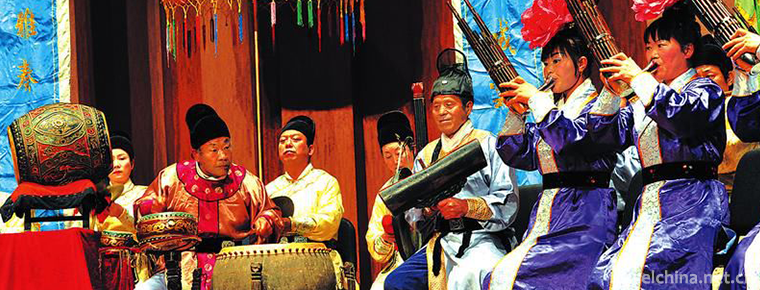
-
Guilin Happy Land Theme Park
Guilin Lemandi theme park Gudong Waterfall is suitable for sightseeing all the year round. April-October is the best time for Guilin tourism. The scenic spot is located in Guilin.
Views: 155 Time 2018-12-12 -
Tianxin Pavilion
Tianxin Pavilion is located in the southeast corner of Changsha City, Hunan Province. It is a tower on the ancient city wall of Changsha where Chengnan Road meets Tianxin Road..
Views: 118 Time 2019-02-22 -
Ah Xi Xian Ji
"Xianji" is an epic of the Ashi people of the Yi tribe, which is spread orally among the Ashi people in the Xishan area of Maile City, Yunnan Province. "Xianji" is the transliterat.
Views: 198 Time 2019-03-28 -
Sichuan Opera
Sichuan Opera, commonly known as Sichuan Opera, is mainly popular in the Han nationality areas of Sichuan, Chongqing, Yunnan and Guizhou provinces in southwestern China.
Views: 181 Time 2019-04-19 -
Lantern show
Lantern Opera is not only a traditional folk opera with local characteristics in Chongqing and Sichuan, but also one of the important voices of Sichuan Opera. It originates from northeast Sichuan.
Views: 143 Time 2019-04-26 -
Jiaodong drum
Jiaodong Drum is a folk folk folk art form which originated in the coastal counties of Jiaodong Peninsula. It has a history of more than 260 years so far. It originated from the blind.
Views: 316 Time 2019-05-06 -
Ancient dance Lao Gu dance
Ancient dance, the meaning of "breaking through the barrier" in Li language, is called "ancestor-telling" in ancient books. The ancestor worship originated from the primitive socie.
Views: 131 Time 2019-05-11 -
Miao folk songs
According to its content, Miao folk songs can be divided into Youfang song (love song), wine song, bitter song, anti-song, funeral song, labor song, political song, children's song, riddle song and so.
Views: 88 Time 2019-06-05 -
Qiyang Opera
Qi Opera is one of the traditional local dramas in Hunan Province. It is also called Qiyang Band, Qiyang Opera in the early years of the Republic of China, and Qiyang Qidong Opera in the folk.
Views: 95 Time 2019-06-10 -
Central Crossing of Flyover
Zhongbian is a local traditional folk acrobatics in Beijing. Beijing's overpass is a prosperous and lively civilian market with a long history, well-known at home and abroad. During the reign of Emper.
Views: 234 Time 2019-06-21 -
Ulger
Uliger, which means "storytelling" in Mongolian, is commonly known as "Mongolian Shushu", "Mongolian Shushu" and "Mongolian Qinshu". It is a form of music art t.
Views: 145 Time 2019-06-29 -
Flag dress of Qing Dynasty
In the strong feudal ethical atmosphere of the Qing Dynasty, it is impossible for women to show their curves as modern. In the Qing Dynasty, the cutting system of flag dress always adopted straight line, and the chest, shoulder, waist and buttocks were .
Views: 65 Time 2020-12-11
